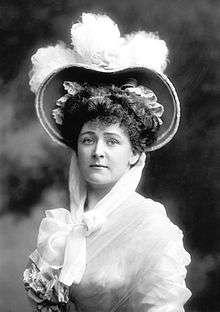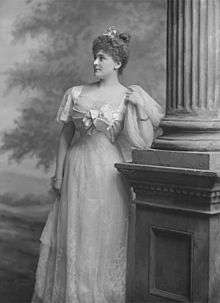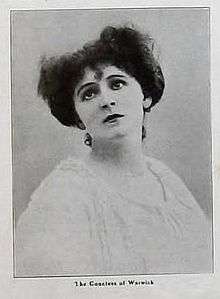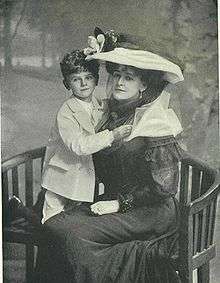Daisy Greville, Countess of Warwick
| The Right Honourable The Countess of Warwick | |
|---|---|
 Daisy Greville, 1899 | |
| Born |
Frances Evelyn Maynard 10 December 1861 Easton Lodge |
| Died | 26 July 1938 (aged 76) |
| Spouse(s) | Francis Greville, 5th Earl of Warwick |
| Children | Leopold Greville, 6th Earl of Warwick |
| Parent(s) |
The Hon. Charles Maynard Blanche Fitzroy |
Frances Evelyn "Daisy" Greville, Countess of Warwick (10 December 1861 – 26 July 1938)[1] was a British socialite and long-time mistress to Albert Edward, Prince of Wales, who later became King Edward VII.
She was the inspiration behind the popular music hall song Daisy, Daisy.[2]
Family
Born at Easton Lodge near Great Dunmow, she was one of three children of Colonel The Honourable Charles Maynard and his second wife Blanche FitzRoy. Charles Maynard was the eldest son and heir apparent of Henry Maynard, 3rd Viscount Maynard, whose estates Greville inherited in 1865 upon the Viscount's death,[3]her father having died three months before. Blanche FitzRoy was a descendant of Charles II through his mistresses Nell Gwyn and Barbara Villiers. Two years after her father's death, her mother married 33-year-old Lord Rosslyn, a favourite courtier of Queen Victoria. They had five children, Greville's half-sisters, including Sybil Fane, Countess of Westmorland; Millicent Leveson-Gower, Duchess of Sutherland; and Lady Angela Forbes.
Marriage
At one stage, Frances Maynard was considered as a possible wife for a younger son of Queen Victoria—Prince Leopold (later Duke of Albany). The Queen approved, but the Prince was in love with someone else.[4]
Instead, she married Francis Greville, Lord Brooke, the eldest son and heir of George Greville, 4th Earl of Warwick, in 1881.[5] The couple had three children in the first four years of their marriage.[1][5] Her fourth child, a son called Maynard was born in 1898, and a daughter Mercy was born in 1904. Lord Brooke succeeded to the Earldom in 1893, and the family moved into Warwick Castle.
Personal life




Following her marriage and the birth of her children, she became a socialite, often attending lavish parties and gatherings. She and her husband were members of the Marlborough House Set, headed by Albert Edward, Prince of Wales (the future Edward VII). Beginning in 1886, she became involved in affairs with several powerful men, most notably the Prince of Wales.[6]
Lady Warwick began an affair with Lord Charles Beresford, and was outraged to discover Lady Charles Beresford was pregnant by her husband. She suddenly dispatched a violent letter to Lord Charles, but it was intercepted by Lady Charles, who read the letter contents with dawning horror. Others who read it, including Charles's brother, Lord Marcus Beresford agreed it "ought to have never seen the light of day". Lady Charles promptly handed over the letter to Sir George Lewis, 1st Baronet, society's discreet solicitor, for safe-keeping. The Prince of Wales was now involved in the matter, roped in by the Countess of Warwick's pretty tears, with her eventually becoming the Prince's semi-official mistress. The Prince hoped to convince Lady Charles to give up the letter for its destruction, however she gave Lady Warwick an ultimatum: stay away from London that season and the letter would be returned. Lady Warwick refused this edict, and the Prince of Wales made the situation worse by hinting to Lady Charles that the position she and her husband held in society would be endangered. This angered Lord Charles enough to push the Prince of Wales against a sofa. The Prince forgave Lord Charles for his actions, but the scandal placed a definite strain on the friendship of the two men. The quarrel lasted until Prime Minister Lord Salisbury intervened and both parties reached an agreement. Nevertheless, the relations between Edward VII and Lord Charles remained weak for the remainder of their lives.[6]
After her affair with the Prince of Wales ended in 1898, she fell in love with Joseph Laycock, a millionaire bachelor who served as an army officer in the Boer war. He fathered two of her children, Maynard and Mercy. However, Laycock was also seeing the Marchioness of Downshire, and when the Marquess of Downshire threatened divorce over her affair, this menage-a-trois set society's pens ablaze with letters deploring, snickering at, and gossiping about such scandalous conduct. Laycock married Lady Downshire after her divorce, and the heartsick Lady Warwick was forced to attend to other matters, such as her near poverty. Years of lavish entertainment and socialite pursuits had depleted the immense fortune she had inherited from her grandfather.[7]
Her main flaw when acting as a courtesan for powerful men was that she lacked the ability to keep her affairs private, a characteristic which alone could prolong a courtesan's career. Lady Warwick had a distinct habit of divulging to others when she was involved with a man of wealth and power, a habit which amongst other indiscretions[8] earned her the nickname, "The Babbling Brooke."[9]
Later life
Following the death of Edward VII, and having large debts, she tried to blackmail his son, the new King George V. She threatened to make public a series of love letters written by Edward VII that she claimed proved his adultery. It was the cunning expertise of Lord Stamfordham that managed to stop publication by arguing that the copyright belonged to the King.[8] After the High Court restrained her from publishing the letters in Britain, she threatened to sell them to American media. British industrialist and politician Arthur Du Cros offered to pay £64,000 (2012: £6,190,545) worth of Daisy's debts in return for the love letters and for his generosity, he was created a baronet in 1916.[10]
In 1928, Daisy was facing imprisonment in HM Prison Holloway for her debts but was released on condition that if and when she published her memoirs she would "undertake to submit it to a literary man." When her memoir manuscript was eventually submitted it was censored but Daisy's daughter still called it so vulgar that it could only be described as muck. Titled "Life's Ebb and Flow," today, it is considered one of the best-written memoirs on Edwardian society and is often cited. Copies of the love letters were later released to the public by Daisy's daughter; rather than being the passionate love letters claimed by Daisy, they were found to be a mix of gossip and "affectionate banter."[10]
Politics and philanthropy
Robert Blatchford wrote a critique of Lady Warwick's lifestyle in the 1890s, and this led her to seek him out to discuss socialism. His argument had a lasting impact on her, and she joined the Social Democratic Federation in 1904. She donated large amounts of money to the organisation and in particular supported its campaign for free meals for schoolchildren. As a patron of several parishes, she appointed socialist clergy such as Conrad Noel to their livings. She opposed World War I and supported the October Revolution. After the war, she joined the Labour Party.[11]
She also founded a needlework school at Easton in Essex and Studley Agricultural College for Women and hosted meetings of trade unionists at Easton Lodge, which she retained as a private residence after moving to Warwick Castle. She created lavish gardens at Easton Lodge, and also kept a small private zoo. The novelist H. G. Wells was a resident of her Easton estate, letting Easton Glebe from 1910 to 1928.[8]
She threw parties to raise funds to provide the chapel now a part of Warwick Boys' School with a pulpit, known as "Daisy's Pulpit".
During the 1890s, Lady Warwick became acquainted with the novelist Elinor Glyn, whom she introduced into British society.
References
- 1 2 thepeerage.com: Frances Evelyn Maynard
- ↑ Carroll, Leslie. "Royal Affairs: A Lusty Romp Through the Extramarital Adventures That Rocked the British Monarchy". Edward VII and Daisy Greville, Countess of Warwick 1861–1938: NAL Trade. ISBN 0-451-22398-5.
- ↑ Anand, Sushila The Life and Loves of the Countess of Warwick, 2008
- ↑ Carroll, Leslie. "Royal Affairs: A Lusty Romp Through the Extramarital Adventures That Rocked the British Monarchy". NAL Trade. ISBN 0-451-22398-5.
- 1 2 University of Hull, Directory of Royal Genealogical Data: Frances Evelyn Maynard
- 1 2 The many scandals of the Marlborough house set, Edwardian promenade: Daisy Greville, Countess of Warwick
- ↑ Holland, Evangeline. "Society and Scandal in Edwardian England". Edwardian Promenade.
- 1 2 3 A life of contrast daisy warwick, Edwardian promenade: Daisy Greville, Countess of Warwick
- ↑ Holland, Evangeline (27 August 2007). "The many scandals of the Marlborough house set". Edwardian promenade. Retrieved 6 March 2012.
- 1 2 Ridley, Jane (2012). Bertie: A Life of Edward VII. Random House. p. 489 - 490. ISBN 9781448161119.
- ↑ Martin Crick, The history of the Social-Democratic Federation, p. 318
Bibliography
- Anand, Sushila. (2008). Daisy: The Life and Loves of the Countess of Warwick. Piatkus. ISBN 978-0-7499-5169-6
- Lang, Theo. (1966). My Darling Daisy. London: Michael Joseph
- Blunden, Margaret. (1967). The Countess of Warwick. London: Cassell & Co
- Warwick, Frances, Countess of. (1929). Life's Ebb and Flow. New York: William Morrow & Company
- Warwick, Frances, Countess of. (1931). Discretions. New York: Charles Scribner's Sons
- Aronson, Theo (1988). The King in Love: Edward VII's Mistresses. London: Guild Publishing. ISBN 978-0-552-13515-3.
External links
| Wikimedia Commons has media related to Daisy Greville, Countess of Warwick. |
- Works by or about Daisy Greville, Countess of Warwick at Internet Archive
- A Countess and her Castle: Warwick Castle in 1900
- Babbling Brooke's doomed romance Article in the Daily Mail by Juliet Nicolson
- A life in contrast: Daisy, Countess of Warwick By Daisy's biographer Victoria Fishburn